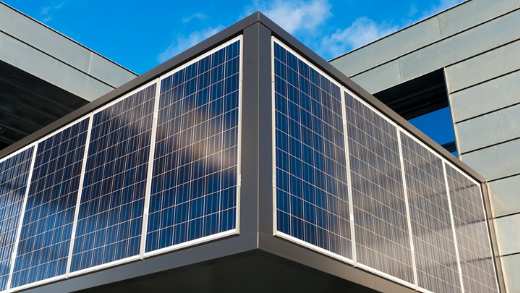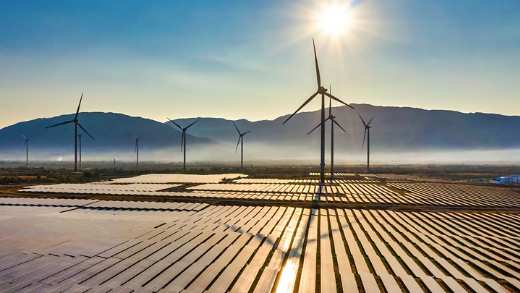Infrastructure demonstrated characteristic resilience in 2023 in the face of significant macroeconomic headwinds. Darryl Murphy from our infrastructure team explains why he expects current themes to persist in 2024.
Read this article to understand:
- The drivers of infrastructure deal activity in 2023
- The five themes expected to dominate market activity in 2024
- Next steps in offshore wind and nascent technologies including carbon capture, utilisation and storage
Infrastructure investors will not shed too many tears as we wave goodbye to 2023, a year that saw the impact of macroeconomic shifts reflected in weak capital raising, falling valuations and reduced deal activity. Now optimism is picking up on the basis the market is settling down as inflation steadily falls. The general consensus is that risk-free rates will remain “higher for longer”. So, what will 2024 bring?
In the UK and the US, we have looming elections which could affect the level of deal activity. Looking back at 2023, infrastructure debt deal activity was not as low as one might have expected, and certainly greater than in other asset classes such as real estate. European deals totalled around €125 billion, the lowest level since 2017 and over 30 per cent down on 2022.1
In the UK, volume reached £28 billion. Unusually, the UK was not the most active country in Europe, with Germany closing around €32 billion of deals, principally helped by two mega telecom tower transactions. Spain also showed a lot of activity, principally in solar energy, with 93 deals closing for €14 billion, around the same number of deals as seen in the UK.2
By sector, activity was dominated in volume by solar, followed by onshore wind and fibre. In terms of total capital invested, telecom towers delivered €20 billion, just ahead of offshore wind with €19 billion. At a thematic level, energy transition and digital deals dominated activity, with solar, fibre and data centres making up 60 per cent of total infrastructure debt market activity for the year. It is also worth noting €12 billion of financing was agreed for gas pipelines, compared to just over €1 billion for battery storage.3
Key infrastructure investment themes for 2024
As we look ahead, do we expect to see any significant changes to the landscape? The focus on energy transition and digital is likely to remain; public-private partnerships in social infrastructure are very much in the minority across Europe; and while some large transport investment is expected, it will not dominate the shape of the market. However, we anticipate an increase in the volume of activity.
Infrastructure equity valuations are beginning to settle after a delayed correction following the impact of increased risk-free rates; there is now greater evidence of price discovery in the market. It is also worth noting some infrastructure funds are experiencing redemption requests, in particular from UK corporate defined benefit pension schemes that are now fully funded and looking to move to buy-out, and hence move out of their illiquid investments. This is beginning to result in assets coming to the market which will help boost the M&A market, which struggled in 2023.
Borrowers are accepting the higher-for-longer outlook and no longer hesitating to come to the market
In addition, borrowers are accepting the higher-for-longer outlook and no longer hesitating to come to the market if they need to raise more debt or refinance. Credit spreads saw a small correction at the end of 2022 but there has not been any prospect of a major pricing correction. Furthermore, debt pricing for renewable energy assets remains very tight and offers limited illiquidity premia to relative value investors. This is most evident in the renewables sector, where bank financing remains very active and institutional debt opportunities are limited due to tight pricing.
The projected continued growth in renewable energy, especially UK offshore wind, will inevitably need capital and borrowers are likely to need to bring together bank and institutional debt financing. Furthermore, commercial banks are building, or in some cases rebuilding, “originate to distribute” models, which rely on syndication to the wider bank market. This will continue; banks have now realised the institutional market is well suited to the longer-term “take and hold” business model.
The themes that shaped the outlook last year look set to remain key areas for many years to come. Hence, the title of this article: Plus ça change, plus c’est la meme chose – the more things change, the more they stay the same. Given infrastructure is a long-term, stable asset class, perhaps slow evolution is always inevitable.
1. Post-COVID meets ESG
For the significant numbers of people in the UK currently experiencing COVID-19, it is most definitely not an “historical” experience. Whilst society continues to adapt following the pandemic, infrastructure investors remain focused on the recovery of one sector in particular: airports.
A number of airport refinancings took place in 2023 and pressure on shareholders to restore value in the assets is likely to mean continued financing activity. However, the sector now faces a new challenge as ESG “gets real” for investors.
Infrastructure offers potential for a positive alignment of investment outcomes with positive ESG characteristics
For many investors, infrastructure offers potential for a positive alignment of investment outcomes with positive ESG characteristics. In the energy sector, it is now common to exclude coal-based assets and the vanguard of the debate has been around the usage of oil and gas. The increased focus on energy security, a key theme since the Russian invasion of Ukraine, has forced investors to take a more balanced and pragmatic approach to the pace of the energy transition.
The debate on wider sectors is becoming more apparent, most notably within air and road transport. While we are not likely to see many new-build investments in these sectors, for many investors the carbon intensity of these assets from the perspective of Scope 3 – a category that relates to customer and supply-chain emissions – remains a concern.
While the development of sustainable aviation fuel and the increase in electric vehicles (EVs) will reduce emissions, borrowers in these sectors may find investors caught between supporting the longer-term transition and the decarbonisation of their own portfolios. This could lead to increased pricing for these sectors if liquidity becomes tighter.
2. Decarbonisation
The last two decades were a period in which infrastructure development was seen as the key contributor to economic growth, but there has been a paradigm shift. Infrastructure investment over the next 20 years will undoubtedly be shaped by decarbonisation and governments’ transition to net-zero targets.
For now, demand for net-zero assets is materially greater than the supply of suitable investments. In 2023, thoughts turned to the practical issues constraining development of core renewables in terms of planning, consents and grid connections in the UK. While every effort is being made to resolve these constraints, the UK has also seen the impact of the macroeconomic conditions on offshore wind, with a much-publicised lack of projects being awarded Contracts for Difference (CfD) subsidies.
The results of AR6 should see a larger pipeline of offshore wind delivered in 2025-2026
This will inevitably mean a hiatus in the offshore wind pipeline, which should be rectified later this year when the sixth allocation round (AR6) under the CfD scheme will see an adjustment to the maximum strike price. The results of AR6 should see a larger pipeline of offshore wind delivered in 2025-2026, and this may lead to a tightening of liquidity and wider opportunities for institutional investors, given the asset class has been financed in the bank market through an oversupply of tightly priced capital to date.
2024 should also see carbon capture, usage and storage (CCUS) projects delivered in the UK market. Both the HyNet and East Coast clusters (planned to integrate hydrogen production, supply and utilisation with carbon capture and sequestration, using depleted natural gas sites for carbon storage) could see transport and emitter projects reach financial close.4,5 The clusters were selected in 2021, which illustrates the time necessary to develop such complex projects, but has also led to frustration from investors that opportunities to deploy capital feel far off in the future rather than available in the present.
In terms of the more nascent sectors such as hydrogen, the recent announcement from the UK government giving support for 11 projects to produce green hydrogen will be interesting to watch, to see how quickly these schemes will be delivered to the market.6 This will be a key step in a sector that has been much talked about but has yet to lead to opportunities to deploy capital at scale.
Development of SMRs will continue but they are not likely to be scalable and deployed until the next decade
Nuclear remains very much in the background. At the risk of repeating an often-used phrase, this should be the year when the Sizewell C power station makes progress towards financial close. However, the ongoing process to raise private equity capital continues, as does debate on the merits of using public or private debt capital, suggesting the scheme still has some way to go. Development of small modular reactors (SMRs) will continue but they are not likely to be scalable and deployed until the next decade.
Battery storage has seen an increase in activity, with a significant level of investment over the past 12 months, albeit in a sector where long-term stable cashflows are not so certain. This field requires a deep understanding of the inherent volatility of the UK energy market.
3. Regulation to competition
The regulated utility market will continue to attract scrutiny, not least in the water sector, with the next periodic Price Review, PR24, determining prices for 2025-2030.
Investors hope DPC will lead to a deeper pipeline of other major capital projects for water companies in the future
The long-awaited competitive procurement model, Direct Procurement for Customers (DPC), will see the first project, Haweswater Aqueduct Resilience Programme, reach preferred bidder and work towards financial close.7 This promises to be another key deal of 2024, which should enable the replacement of sections of the tunnel along the aqueduct that runs from the Lake District to Greater Manchester. Investors hope it will lead to a deeper pipeline of other major capital projects for water companies in the future.
Electricity transmission has been very much in the news in 2023, given the publication of the Winser Report on how to accelerate the critically needed transmission infrastructure across the UK.8 The role of competitive tendering remains part of the potential solution, but any concrete plans still look to be some way into the future.
4. Consolidation in fibre broadband
The sector that felt the most acute impact in terms of the macroeconomic environment, with a severe reduction in liquidity in 2023, was UK fibre. Whilst we have seen large financing deals in the sector in France, Germany, Italy and Spain, the fragmented UK market has witnessed something of a perfect storm. Liquidity started to dry-up dry up after the failed syndication of Cityfibre at the end of 2022. With evidence of decreased equity appetite from investors and overbuild in urban areas has come the realisation that a market of over 100 alternative networks is not sustainable.
Fibre companies are focusing on how to increase customer penetration and become cashflow positive
Companies such as Hyperoptic and Gigaclear, which had existing debt facilities, have been able to obtain greater financing, but smaller entities have not found it easy to attract capital. This could accelerate potential mergers and consolidation in the market, as companies move from a “build it and they will come” perspective to an absolute focus on how to increase customer penetration and become cashflow positive.
There are potential lessons to be learnt from the fibre sector that should be carried across to the nascent EV-charging market. Last year was not the greatest for the sector, with a low deployment of chargers and general take-up of EVs slowing down. The experience in fibre does show a laissez-faire market will not always deliver an optimal outcome, and there will need to be a careful balance of competition versus effectiveness in EV charging to ensure every pound invested generates true value.
5. Evolution of the UK Infrastructure Bank
In 2023 the UKIB really gained momentum and is becoming ever more visible across a range of sectors. It released its Strategy Update in September, setting out its vision of how it intends to work with the market.9
UKIB engaged in a broad range of activity in 2023, with investments in water, forestry, battery storage and EV charging, along with ongoing activity in the fibre sector. The bank also moved further into direct equity deals, with interesting investments into Cornish Lithium and Pragmatic Semiconductors demonstrating its ability to invest across the capital stack and fill gaps in the market.
Opportunities may arise in the future in terms of CCUS, DPC and even in competitive sectors such as OFTO
The challenge for UKIB remains the lack of “mega-deals” in the past few years, but opportunities may arise in the future in terms of CCUS, DPC and even in competitive sectors such as offshore electricity transmission ownership (OFTO).
UKIB’s guarantee scheme has been utilised – most recently in the Gigaclear fibre debt financing. However, institutional insurance investors have mostly engaged in considering the potential to utilise UKIB’s credit enhancement facility, similar to the scheme offered by the European Investment Bank post the financial crisis, to potentially provide a means to move assets from sub-investment grade rating to investment grade and hence make them more capital efficient for insurance capital under Solvency II.
It is also worth noting that the Solvency UK proposals look set to increase the appetite of insurance capital for productive finance; the Association of British Insurers anticipates insurers will invest over £100 billion in the next ten years.10 Hence the capital demand for investment will grow and put pressure on the pace of delivery of suitable investments.
Similar, but different
Our themes show how much activity in 2024 is expected to run on from already established market dynamics. Net-zero targets remain a key focus of governments. Investors will be keen to ensure there is momentum over the next five years to ensure the necessary volume of investment is deployed, with important next steps anticipated in established and nascent technologies.


















